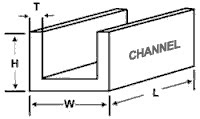Understanding C Channel Weight Calculator and ISMC Weight Chart: A Comprehensive Guide

When it comes to structural engineering and construction, ‘C’ channels play a pivotal role in providing support and structural integrity to various projects. These channels come in different sizes and dimensions, and understanding their weight calculations is essential for ensuring the structural stability of any construction. In this comprehensive guide, we will delve into the intricacies of ‘C’ channel weight calculation, using keywords such as ISMC weight chart, C channel weight calculator , U channel weight calculator, MS channel 100x50x6mm, c channel, u channel, ISMC channel weight calculator, and MS channel weight chart. The Basics of ‘C’ Channels ‘C’ channels, also known as C beams, are commonly used for structural support in various applications, from building frames to machinery supports. They are characterized by their ‘C’ shape and are available in a variety of sizes and materials. ‘C’ Channel (Kg) — 0.7843 kg/cm² per metre length. To ensure that a ‘C’ channel is suitable fo